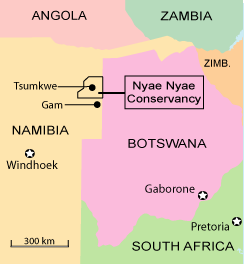A new study by the International Institute for Environment and Development (IIED) singles out the Yanadi as an example of an indigenous society with traditional knowledge that needs to be preserved. The IIED released its work on the Yanadi last week, along with studies on other traditional societies in India, Peru, Panama, China, and Kenya. Those publications are the culmination of research that anticipates a major, upcoming meeting of the World Intellectual Property Organization (WIPO) titled “Conference on Intellectual Property and Public Policy Issues,” which will be held in Geneva July 13 – 14.
The institute, a respected non-profit research organization based in London, describes WIPO as one of the major threats to Yanadi knowledge. According to the WIPO website, it is “a specialized agency of the United Nations … dedicated to developing a balanced and accessible international intellectual property (IP) system, which rewards creativity, stimulates innovation and contributes to economic development while safeguarding the public interest.”
Judging by a press report, it appears as if the Yanadi study recognizes the importance of biodiversity in the region of Andhra Pradesh where they live. The study says that the Yanadi “have developed extensive knowledge of bio-resources, medicinal and aromatic plants and wild foods—including unique remedies for snake bite, paralysis, [and] skin diseases,” due to their intense involvement in their forests. The people play a major role in understanding, utilizing, and preserving those forest resources.
The study charges that when the Yanadi were relocated away from their forests, they became isolated from the sources of their livelihood. They had to subsist on wage labor and the collection of minor, non-timber forest resources. The traditional knowledge of the people, the study says, is “on the verge of extinction. The youth are not interested in learning it, and the status of elders is weakening due to the extension of government control.”
The focus of the report is on Yanadi knowledge of plants that can be used for medicinal purposes. That knowledge is not recognized by official agencies, and it is labeled by bureaucrats, in the words of the study, as the “superstitious knowledge of illiterates.” This attitude makes the people fearful of openly discussing what they know.
A 1995 ethnography of the Yanadi by Stanley Jaya Kumar briefly discusses some of these same issues. The author mentions forest resources used by the Yanadi at the time of his investigation—flowers, fruits, bark, tubers, edible roots—and he provides a table listing some of them. Stanley Jaya Kumar indicates that the Yanadi did not reveal the names of medicinal plants; they preferred to use the plant medicines personally, and to keep their knowledge to themselves.
The IIED study points out that the Yanadi harvest wild plants and use them in specialized rituals held in sacred forests. They transmit their medicinal knowledge through rituals as well. They believe that cultivating plants will destroy their potency. The study asserts that traditional people like the Yanadi must retain access to their forests in order to maintain their knowledge of the medicinal properties of plants. The Yanadi continue to visit forestlands to worship forest deities, revere plants, and show respect to their ancestors.
An essential element in the IIED argument is that the Yanadi consider forest resources to be communal property. That approach differs from that of WIPO and the rest of the developed world, which seeks to protect individual and corporate intellectual property rights. The point of the study is to challenge the WIPO way of thinking, which, in this upcoming meeting, will seek to reconcile the difference between the intellectual property standards of the world and the approaches of traditional societies that emphasize communally-shared knowledge. Many other traditional societies not identified by the IIED, such as the Piaroa, also try to protect their customary plant knowledge.
According to the IIED, WIPO’s attempt to find common elements among traditional knowledge systems and the worldwide standards is fundamentally flawed. International standards have been developed to protect Western commercial uses of drugs, which are developed by private companies for the profits of their owners. Traditional societies such as the Yanadi, on the other hand, do not privatize their knowledge—they have no such thing as patent or copyright protection.
The IIED argues that traditional societies like the Yanadi also protect biodiversity by approaching nature as a public resource. Furthermore, the growing inability of traditional communities to share their knowledge of plants and their possible uses could hinder human responses to major worldwide problems, such as global climate change.
The institute urges policymakers to accept several key arguments: the importance of collective ownership and rights to knowledge in traditional contexts; the need to develop viable ways of sharing benefits with traditional societies; the value of acknowledging customary rights to genetic resources; and the significance of managing external uses of traditional knowledge fairly, but within the protocols of the traditional communities.
The IIED also issued a four-page briefing paper at the same time it released its detailed studies to the press. The paper, “Protecting Traditional Knowledge from the Grassroots Up,” reiterates and clarifies the arguments. It points out that “the rights of people holding traditional knowledge are increasingly violated by unfair patents and the extension of Western intellectual property rights ….” Legally binding treaties protect inventors in the industrial countries, it says, but there are no such protections for the traditional knowledge of pre-industrial societies.
This lack limits the protection of biodiversity. Furthermore, in the current system, “indigenous communities in rural areas rely profoundly on healthy ecosystems for their survival, so protecting and conserving biodiversity is integral to their cultures.” The briefing paper emphasizes the importance of protecting customary knowledge for all of humanity.
 The difficulties began in
The difficulties began in 